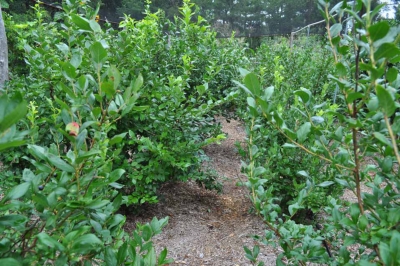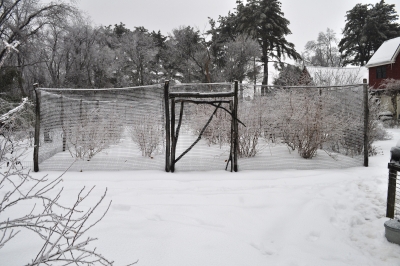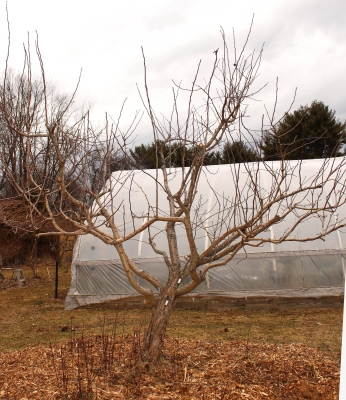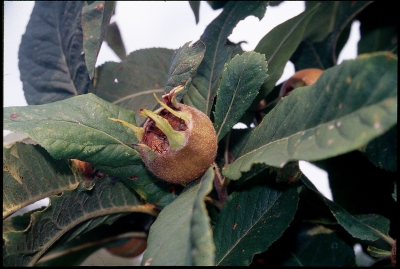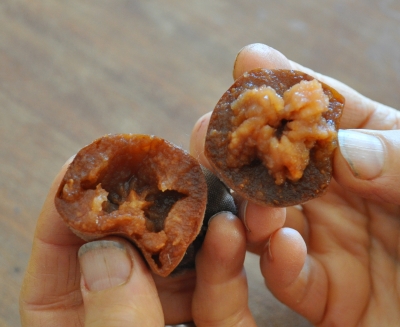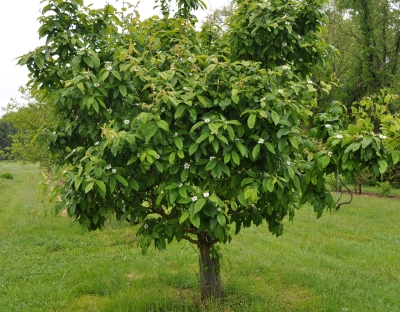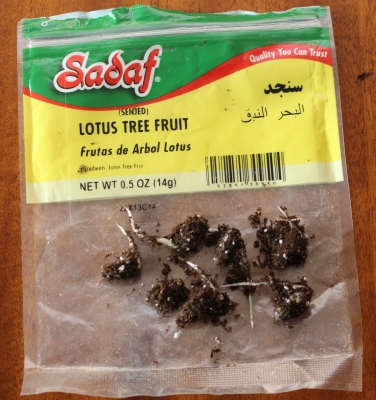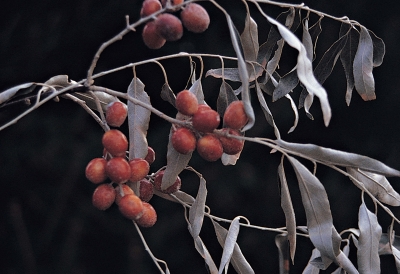BLUEBERRIES OUTSIDE, APHIDS INSIDE
/12 Comments/in Fruit, Gardening, Pests, Pruning, Soil/by Lee ReichPlant the Best-Tasting Fruit
My sixteen blueberry plants keep me in blueberries year ‘round, so I’m not planting any this year. But you are, or should be. The bushes are attractive in every season, with white blossoms in spring, foliage that looks spry all summer and turns crimson red in fall, and stems that shade to red in winter. The bushes are almost pest-free. And the berries are healthful and delicious.
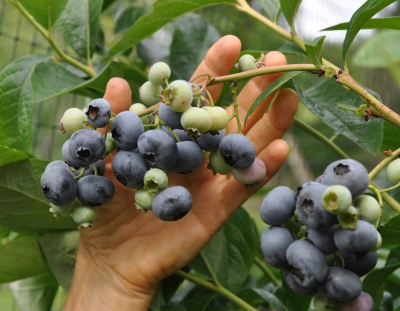
 All you would-be blueberry planters out there: Pay attention to the soil for your plants, about which I’m going to offer advice. Too many people plunk a blueberry bush into a hole dug in their lawn and then wonder about the lack of berries. Poor growth, that’s why. The plants bear fruit on one year old stems. If shoots grow only a few inches one year, there’s little room on which to hang berries the following year.
All you would-be blueberry planters out there: Pay attention to the soil for your plants, about which I’m going to offer advice. Too many people plunk a blueberry bush into a hole dug in their lawn and then wonder about the lack of berries. Poor growth, that’s why. The plants bear fruit on one year old stems. If shoots grow only a few inches one year, there’s little room on which to hang berries the following year.
Taking a cue from wild blueberries, here’s what the bushes need, soil-wise: acidity (pH 4-5.5), organic matter, relatively low fertility, moisture, air, and no competition from weeds. For starters, check the soil pH with either a home testing kit or by taking a sample to a Cooperative Extension office or soil testing laboratory. If soil is not sufficiently acidic, add sulfur, preferable pelletized sulfur for ease of handling, 3⁄4 pound of sulfur per 100 square feet in sandy soils or three times this amount in heavier soils, for each pH unit the soil is above 4.5. Contrary to popular myth, adding oak leaves or pine needles will NOT do the trick. Spread sulfur over the ground as far as the eventual spread of the roots, which is about 3 feet in all directions.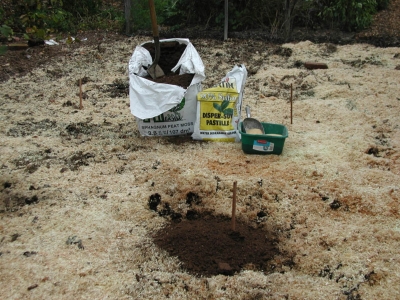
Then dump a bucketful of peat moss right where you plan to dig each hole. Dig the hole deep and twice as wide as needed to get the plant in the ground, mixing the peat moss with the soil. Peat moss provides a long-lasting source of organic matter, which also helps with aeration and water retention.
Finally, plant and water.
Wait, you’re not finished yet. Right after planting, spread some organic mulch, such as wood shavings, leaves, or pine needles, a couple of inches deep and as wide a spread as the roots. Mulch keeps the soil moist and further enriches the ground with organic matter as its lower layers decompose.
Soil & Birds
Ongoing soil care for blueberry bushes is simple and necessary, mostly food and drink.
Assuage the bushes’ thirst with, barring rain, three-quarters of a gallon of water per week for each square foot spread of the roots. Satisfy their hunger by spreading a high nitrogen fertilizer late each fall. I use an organic fertilizer, such as soybean or alfalfa meal, at the rate of 1.5 pounds over every hundred square feet of root spread. These fertilizers offer nitrogen throughout the growing season in a form blueberries can use.
Periodically re-check the soil pH and add more sulfur, if needed. Replenish the mulch each fall, laying the new mulch right on top of the old mulch.
For the future — harvest of first berries should begin within a couple of years — think about birds. Are you going to share? Are they going to share? I opt not to share, enclosing my whole planting in netting, to create a walk-in “blueberry temple.”
Aphid Attack & Counterattack
Turning inward, not introspectively, but to the greenhouse, I see aphids getting a foothold. Their populations soared a few weeks ago as young and old feasted on aging celery and arugula plants beginning to send up seed stalks.
My first counterattack was to cut down or dig up these old plants and whisk them to the compost pile before too many insects dropped off to take up residence on smaller plants and seedlings. Not that there weren’t plenty of stragglers fattening up on younger plants.
My tack with the stragglers has been to set my watering wand on “fan spray” and blast the plants with water. Most aphids that get knocked off plants don’t return. I spray on mornings of sunny days so leaves dry relatively quickly, limiting potential disease problems. The temporary increase in humidity might increase the likelihood of aphids’ getting fungal diseases, to which they are very susceptible.
Of less effect are the ladybugs I periodically introduce into the greenhouse, in large part because I don’t have enough of them. They used to enter my home in large numbers via leaks around an old, south-facing window and nearby crack in the wall. I’d merely vacuum them up as they clustered on the window pane and shake the contents of the hand-held vacuum among plants in the greenhouse late in the day. That window and the wall crack have been repaired, so few ladybugs end up indoors.
I’m considering making a hole in the wall to let the ladybugs indoors again and hanging a ladybug live trap (available commercially or made from online plans at http://www.ars.usda.gov/is/br/lbeetle/001030.trap.pdf) right near the hole.
Thus far, though, cleanup and water sprays have kept aphids under control, and plants are growing well. Once transplanted outdoors aphid problems vanish because of the weather and natural predators.
POPPING, PRUNING, AND EATING
/3 Comments/in Fruit/by Lee Reich
Popcorn Gets Bigger, But Medlar Is Still Ugly (Not To Me)
A couple of weeks ago I wrote about increasing the poppability of my home-grown popcorn by exposing the kernels to the vapor of a saturated salt solution. Pennsylvania Dutch Butter Flavored popcorn, a variety that usually pops fairly well, popped to 1/3 greater volume.
This week Pink Pearl, a variety that’s not usually a very good popper, underwent testing. The result: No effect of the treatment; both the treated and untreated batches popped pretty well. Was it the change in the weather, stronger hints of spring? Perhaps. (Previously, I pointed out how cold weather outside turns indoor air drier, perhaps too dry for good popcorn popping.) At any rate, Pink Pearl was tasty.
Medlar Teaches How To Prune A Fruit Plant
The weather change also had the effect of drawing me outdoors more — for pruning. Looking at my medlar tree’s branches going every which way, I scratched my head (figuratively) wondering where to start, what to cut.
Medlar is a fruit tree (more on medlar later), and the first step in pruning any fruit tree is attending to light. Light provides the energy for photosynthesis which translates into flavorful fruits. The goal is to let every branch bathe in sunlight, which also helps thwart potential disease problems.
So I stopped scratching my head and started with a few dramatic pruning cuts, lopping some of the larger limbs back to their origins. Medlar has a naturally spreading growth habit, so cuts were aimed at removing limbs trying to fill in and shade the the center of the tree. I wanted a whorl of branches reaching up and out.
Next to go were dead, diseased, and broken branches. I saw remnants of cicada damage from two years ago. Away with most of those stems also.
For the next cuts, you have to know how a particular kind of fruit tree bears fruit. At one extreme are peaches. They bear only on one-year-old stems so need aggressive pruning each year to stimulate new shoots that become next year’s bearing, one-year-old stems. At the other extreme are apple and pear trees. They bear fruit on long-lived spurs, which are stumpy, branching stubs that develop on older limbs, so relatively little pruning is needed.
Medlar’s bearing habit lies somewhere between those two extremes. I shortened a few very old branches to invigorate them with new growth.
On most fruit trees, drooping branches make poorer fruit. Probably for medlar also. So off came the drooping branches, either back to non-droopy portions or to their origin.
Finally, some detail work: shortening or removing those vigorous, vertical shoots called watersprouts; thinning out smaller areas of congested branches; removing stems growing too close to where major limbs exit the trunk; and lopping down root sprouts growing at or near ground level from the rootstock.
Besides fruit, medlar offers beauty. Part of the beauty is the craggy shape of the tree, its muscular limbs clothed in golden brown bark. I stepped back to admire the tree and my work after pruning. If I’ve done a good job, the tree looks happily ready to bask in light and air and, because the major cuts removed limbs at the origin, hardly looks like it’s been pruned.
Medlar Teaches To Eat With Your Tongue, Not Your Eyes
Medlar is a fruit whose popularity peaked in the Middle Ages. Charlemagne was a fan, a big fan who demanded the tree be planted in every town he conquered.
Despite its popularity, even in the Middle Ages, the fruit has often been described disparagingly — for its appearance, though, not its flavor. The fruits resemble small, russeted apples, tinged dull yellow or red, with their calyx ends (across from the stems) flared open. “Open-arse” was the name Chaucer chose. A more recent writer described medlar as “a crabby-looking, brownish-green, truncated, little spheroid of unsympathetic appearance. “ (All recounted, along with information about growing, procuring, and eating medlars in the chapter on medlar in my book Uncommon Fruits for Every Garden.)
Oh, one more quirk about medlar: The fruit, rock hard at harvest, needs to be bletted before eating. This means gently setting it on a counter in a cool room for a couple of weeks, or more, depending to the temperature, during which time the fruit’s interior turns to brown mush. Ugly to look at, but the flavor has a refreshing briskness with winy overtones, like old-fashioned applesauce laced with cinnamon. Between the fruits’ appearance and their need for bletting, you’ll never find medlars for sale on a supermarket shelf.
Perhaps the fruit is ugly. The tree is not. I already mentioned the attractive form and color of the limbs. The white flowers, opening here in May, are like those of a wild rose, each one enhanced because its late opening gets a backdrop of a whorl of already unfurled, dark, green leaves. The tree grows only 8 or 10 feet high and wide and will fruit without another pollinator, so is perfect for a small yard. No need to decide whether to plant a fruit tree or an ornamental tree; medlar is both trees in one.
ELUSIVE AZURE AND FRUIT
/2 Comments/in Flowers, Fruit/by Lee ReichToo Hot Here For These Gems, But Maybe I Can Trick Them
It was decades ago that Norman — gardener, orchid expert, one-time cattle farmer, and lawyer — described to me his first sighting of blue poppy, Meconopsis betonicifolia. He was traveling in England, and at this particular garden was a pond whose far side was electrified by the sky blue petals of blue poppy, perhaps the purest blue of any flower. The mirrored surface of the water stepped up the voltage, as do the frilly clusters of golden anthers trembling in the center whorls of petals.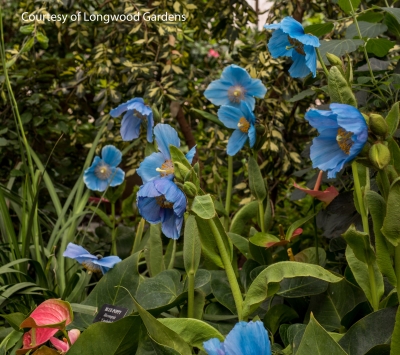
Since then, I’ve lusted for blue poppies but have yet to see the plant in bloom. Twice I tried to grow it, from seed. Each time the seedlings germinated and got off to a good start. Each time, in July, as temperatures here started to get steamy, the plants collapsed, dead. Blue poppy is native above 10,000 feet in the Himalayas and doesn’t like hot weather.
I don’t feel compelled to grow the plant (although that would be nice); I just want to feast my eyes on those bluest of blue petals. To see the plant in bloom requires being somewhere: 1) in late spring or early summer, 2) with cool summers, 3) where blue poppy grows wild or has been planted. The second condition, cool summers, is found in North America in the Pacific Northwest, New England and adjacent parts of Canada, and Alaska. I like hot summers so I’m not relocating to any of these places in order to grow this plant. Also, my garden is particularly needy and entrancing in late spring and early summer, so I’m not leaving then.
I Almost Cross Paths With Blue Poppy, After 20+ Years
As it turned out, I just missed an opportunity to see blue poppy in bloom at Longwood Gardens in Kennet Square, Pennsylvania. Not only is Longwood not far from here, but I happened to be in nearby Philadelphia two weeks ago, when the plant was in bloom. Who would have thought blue poppy could be grown in Pennsylvania?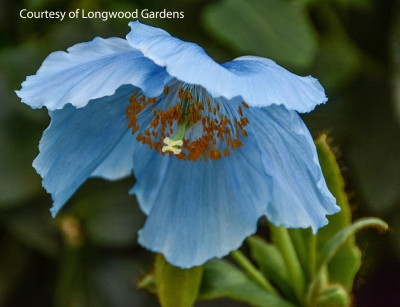 I had, at least, to find out how the plants are grown there. As described by Longwood horticulturalist Jim Harbage, each October Longwood has potted plants shipped from a nursery in Alaska. The plants are put into cold storage until early January, then brought into Longwood’s cool (50-60°F) conservatory to slowly awaken and, finally, blossom in March. After bloom, the plants, although perennials, are discarded.
I had, at least, to find out how the plants are grown there. As described by Longwood horticulturalist Jim Harbage, each October Longwood has potted plants shipped from a nursery in Alaska. The plants are put into cold storage until early January, then brought into Longwood’s cool (50-60°F) conservatory to slowly awaken and, finally, blossom in March. After bloom, the plants, although perennials, are discarded.
Most important is to keep temperatures below 70° F. Research at Longwood Gardens showed that respiration outpaces photosynthesis at warmer temperatures. The plant, essentially, starves. Warmer temperatures also cause some purpling of the petals, ruining the whole reason for growing the plant.
Could Longwood’s prescription be mimicked in my greenhouse? Probably not. Longwood’s large, high-ceilinged conservatory, with dappled shade from tree ferns and citrus trees, perhaps also cooling mists of water puffed into the air as needed, is a lot cooler than my greenhouse. Here, greenhouse temperatures on sunny days in February and March soar, despite vent fans, into the 80s.
How about a sunny window sill? Temperatures are cool in my house, more so the further you go from the woodstove. So that’s a possibility. But purchasing new plants every year could get expensive, especially plants that are good only for compost once their blossoms fade.
How about starting the seeds in early or mid winter for planting outdoors to blossom before temperatures get too hot? Or starting the seeds in fall and exposing the young seedings to very cool temperatures for more assured earlier blossoms outdoors? Blue poppy, if it behaves like many other perennials, should blossom the first season if started very early or if tricked into thinking it’s been through winter before blossoming. I later learned that Chanticleer Garden, also in the Philadelphia region, gets outdoor blossoms from plants purchased in October, wintered in cold frames, then planted outdoors in March. Bloom is in April; composting is in June.
The most important and most reliable route for me to eye blue poppy in bloom is to pencil in a trip to Longwood Gardens for early March next year.
King Red, For Fruit & Beauty, Also Elusive . . . Do Far
My blue poppy experience is reminiscent of my experience with another plant of western Asia, a plant variously called King Red Russian olive, iğde (in Turkey), botanically Elaeagnus angustifolia var. orientalis, or, erroneously, Trebizond date (which is a persimmon species).
King Red is invasive out West but definitely is not invasive here. As with blue poppy, I’ve grown the plant from seed only to have it collapse, dead, when steamy weather arrived.
Beautiful blossoms are not the attraction of King Red, although they do sweetly perfume the air in spring. Rather, it’s the bright red fruit that is highlighted by the gray-green foliage and, when dried, is like sweet talcum powder contained within a cherry-sized, brittle shell. Even without the flowers or fruit, the tree imparts a soft, Mediterranean look to the landscape, much like an olive tree, a relative.
I started some seedlings of King Red Russian olive last year, hoping for some genetic variability in heat tolerance. All the seedlings thrived, probably because of last summer’s relatively cool temperatures.
The seedlings are now dormant in 4 inch pots in my basement. I want 20 foot tall King Red trees so eventually the baby trees need to be planted out. I’m scoping out suitable locations with cooler microclimates. A spot receiving only morning sun is the current best candidate.
Perhaps in a few years I’ll be eating home-grown iğde while enjoying the sight of blue poppies.

